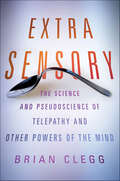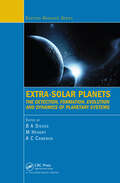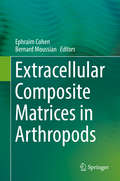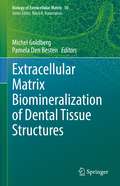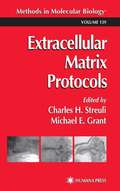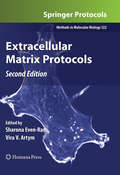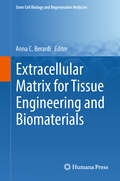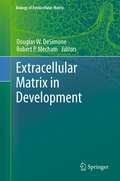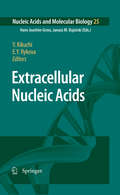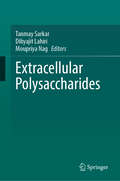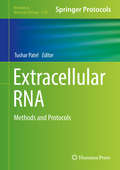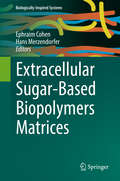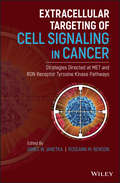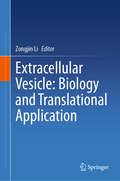- Table View
- List View
Extra Sensory: The Science and Pseudoscience of Telepathy and Other Powers of the Mind
by Brian CleggExtra Sensory is a pop-science look at the untapped abilities of human beings, from ESP to Telekenesis and other real life sciences that are currently being studied today, from physicist Brian Clegg. We'd all love to have 'psi' abilities like telepathy, telekinesis, and remote viewing. But is there any solid evidence to back up these talents, or are they nothing more than fantasy? We still only understand a small percentage of the capabilities of the human brain—and we shouldn't dismiss such potential powers out of hand. Although there is no doubt that many who claim these abilities are frauds, and no one has yet won James Randi's $1M prize for demonstrating ESP under lab conditions, we still have a Nobel prize winner suggesting a mechanism for telepathy, serious scientists researching the field and university projects that produced potentially explosive results. What's the verdict? By looking at possible physical mechanisms for ESP and taking in the best scientific evidence, the reader can discover if this is all wishful thinking and deception, or a fascinating reality. The truth is out there.
Extra-Cranial Applications of Diffusion-Weighted MRI
by Bachir TaouliContinuous improvement in MRI technology in recent years has led to the application of diffusion-weighted MR imaging in organ systems outside the brain. Extra-Cranial Applications of Diffusion-Weighted MRI provides an extensive review of current and future applications of this imaging modality by world-renowned experts. Organized by organ system, each chapter is highly illustrated, offering a balance of protocols, illustrations and principles of image interpretation. An initial chapter provides an overview of relevant physics and other technical details, followed by detailed chapters on all major body systems including liver, kidney, prostate, breast and spine. A final chapter discusses assessment of therapy response. Written and edited by leading DW-MRI experts worldwide, Extra-Cranial Applications of Diffusion-Weighted MRI is an invaluable resource for radiology trainees, practising radiologists and for researchers in a wide variety of disciplines.
Extra-Solar Planets: The Detection, Formation, Evolution and Dynamics of Planetary Systems
by B A Steves M Hendry A C CameronSince the discovery of the first exoplanet orbiting a main sequence star in 1995, nearly 500 planets have been detected, with this number expected to increase dramatically as new ground-based planetary searches begin to report their results. Emerging techniques offer the tantalizing possibility of detecting an Earth-mass planet in the habitable zon
Extracellular ATP and adenosine as regulators of endothelial cell function
by Evgenia Gerasimovskaya Elzbieta KaczmarekExtracellular purines and pyrimidines (ATP, ADP, UTP and adenosine) are released into the extracellular milieu in response to a variety of stress conditions and act as important regulators of vascular homeostasis. This new book is uniquely focused on the signaling actions of extracellular purines in endothelial cells and the crucial role of extracellular purines in regulation of angiogenesis, vascular tone, cell permeability, wound healing, inflammation and cell-to-cell communication. This book examines the responses of endothelial cells, originating from various tissues (such as cornea, pancreas and uterus), to extracellular nucleotides and adenosine under physiological and pathological conditions, i.e. pregnancy, hypoxia, hypertension, inflammation and diabetes. In the book's 12 chapters, the role of purinergic signaling in endothelium-dependent tissue perfusion, regulation of endothelial barrier function, and angiogenesis are discussed. The mechanisms of ATP release and its role in intercellular communication are also presented. In addition, the book provides the most up to date mechanisms of extracellular nucleotide metabolism by purine-converting ecto-enzymes and their contribution to purinergic signaling in endothelial cells originating from various vascular beds. This book is a valuable resource for biomedical research scientists, clinical scientists, graduate students and health science professionals interested in the mechanisms of extracellular purine function in endothelial cells under physiologic and pathologic conditions.
Extracellular Composite Matrices in Arthropods
by Ephraim Cohen Bernard MoussianEmphasis is placed on the elaborate cuticular matrices in insects and crustaceans, spider and insect silks, sialomes of phytophagous and blood-feeding arthropods as well as on secretions of male and female accessory glands. Focus is placed largely on insects, due to the extensive body of published research that in part is the result of available whole genome sequences of several model species (in particular Drosophila melanogaster) and accessible ESTs for other species. Such advances have facilitated fundamental insights into genomic, proteomic and molecular biology-based physiology. This new volume contains comprehensive contributions on extracellular composite matrices in arthropods. The building blocks of such matrices are formed in and secreted by single layered epithelial cells into exterior domains where their final assembly takes place. Additionally, the unique mechanical properties of natural biocomposites like chitin/chitosan, the crustacean mineralized exoskeleton, the pliant protein resilin or insect and spider silks, have inspired basic and applied research that yield sophistical biomimetics and structural biocomposite hybrids important for future industrial and biomedical use. In summary, this book provides an invaluable vast source of basic and applied information for a plethora of scientists as well as textbook for graduate and advanced undergraduate students.
Extracellular Fine Particles
by Yoshinobu Baba Rikinari Hanayama Hidetaka Akita Takao YasuiThis open access book elucidates new biological phenomena caused by extracellular fine particles and highlights the development of base technologies for their control. In this book, the latest knowledge is collected on the principles of extracellular fine particles recognition, action, and biological responses. In addition, the base technologies for their detection, separation, measurement, and analysis are discussed. It also presents the treatment of endogenous and exogenous fine particles and analytical methods as well as functions of extracellular fine particles. This book is useful for undergraduate and graduate students engaged in research on extracellular fine particles, academic and corporate researchers, as well as national think tanks and national policy makers to understand the basics and applications of extracellular microparticles.
Extracellular Matrix
by Jennie B. Leach Elizabeth M. PowellThis volume provides comprehensive procedures for analyzing the extracellular matrix in native, injured, and engineered neural tissues. Divided into four parts, each focusing on different aspects of the extracellular matrix and the nervous system, Extracellular Matrix covers methods to analyze native tissue, in vitro models for investigating cell-extracellular matrix interactions in a variety of contexts, protocols to investigate the role of the extracellular matrix in nervous system injury, degeneration, and regeneration, as well as therapeutics and engineered systems. Each chapter is written by leading experts and presents established protocols in a concise format, encompassing current technologies as well as methods developed over years of research. Beginning with an introduction to the method, chapters continue with a listing of the materials and equipment, step-by-step protocols, and a Notes section with troubleshooting tips, supplemental details and alternative approaches, as well as a list of references for further information. As part of the practical and convenient Neuromethods series, Extracellular Matrix serves as an invaluable aid for researchers studying this vital area of neuroscience.
Extracellular Matrix Biomineralization of Dental Tissue Structures (Biology of Extracellular Matrix #10)
by Michel Goldberg Pamela Den BestenThis book addresses the structural and biological properties of dental and peridental tissue structures and covers their mineralization process. The book contains a description of dentines, cementum, enamel and bone, including collagens, as well as non-collagenous proteins (SIBLINGs, SLRPs, GAGs, PGs, lipids, and MMPs). The mechanisms of mineralization are described in detail and the book is focused on matrix vesicles, collagen mineralization and the role of non-collagenous extracellular matrix components either as promoters or inhibitors of mineralization. In addition, the matrix components (non-collagenous) of enamel (amelogenin, ameloblastin, enamelin, MMP4, MMP20 and other proteases) are reviewed and their respective roles in dental tissues biomineralizations and tissue turnover are discussed. Additionally, environmental factors involved in enamel / dentin defects are adressed. With state-of-the-art contributions from experts in the respective domains, the book is a useful introduction to the field for junior scientists, interested in dental and peridental tissue biomineralization. It is also an interesting read for advanced scientists and clinicians working in dental research, giving them a broader view of the topic beyond their area of specialization.The series Biology of Extracellular Matrix is published in collaboration with the American Society for Matrix Biology.
Extracellular Matrix Degradation
by Robert Mecham William C. ParksRegulated turnover of extracellular matrix (ECM) is an important component of tissue homeostasis. In recent years, the enzymes that participate in, and control ECM turnover have been the focus of research that touches on development, tissue remodeling, inflammation and disease. This volume in the Biology of Extracellular Matrix series provides a review of the known classes of proteases that degrade ECM both outside and inside the cell. The specific EMC proteases that are discussed include cathepsins, bacterial collagenases, matrix metalloproteinases, meprins, serine proteases, and elastases. The volume also discusses the domains responsible for specific biochemical characteristics of the proteases and the physical interactions that occur when the protease interacts with substrate. The topics covered in this volume provide an important context for understanding the role that matrix-degrading proteases play in normal tissue remodeling and in diseases such as cancer and lung disease.
Extracellular Matrix Omics (Biology of Extracellular Matrix #7)
by Sylvie Ricard-BlumThis book covers different omics aspects related to the extracellular matrix (ECM), namely specific omics resources focused on the extracellular matrix (e.g., databases, repositories and atlases), quantitative proteomics applied to specific extracellular matrices (e.g. basement membranes), biological processes such as ECM degradation (degradomics), cell-matrix interactions (adhesomes), signaling pathways, biomarker discovery and diseases, and interactomics (extracellular matrix interaction networks including not only protein-protein but also protein-glycosaminoglycan interactions). The volume also includes recent advances in glycomics and glycobioinformatics applied to proteoglycans and glycosaminoglycans, which are key biological players. The use of omics data to build dynamic models of ECM-regulated biological pathways is addressed, together with the requirement to standardize omic data, which is a prerequisite for the FAIR (Findability, Accessibility, Interoperability, and Reusability) guiding principles for scientific data management.This book will be of great interest to a broad readership from beginners to advanced researchers, who are interested in extracellular matrix omics and will inspire future research topics.
Extracellular Matrix Protocols
by Michael Grant Charles StreuliLeading bench-top experimentalists from around the world present, in a proven format, their state-of-the-art methods for probing the extracellular matrix (ECM), its mechanisms of assembly and how it influences cell behavior. These carefully detailed biochemical, biophysical, genetic, molecular biological, and cell biological techniques have been optimized for the study of ECM structure and assembly, the mechanisms of cell-ECM interactions, and the molecular genetics of ECM proteins and defects in human disease, and bring to a wider audience a range of highly sophisticated methods that have hitherto been difficult even for a few specialized laboratories. Cutting-edge and highly practical, Extracellular Matrix Protocols offers today's ECM researchers a gold-standard collection of powerful, readily reproducible methods to investigate the extracellular matrix and the altered cell-ECM interactions that play so important a role in human health and disease.
Extracellular Matrix Protocols
by Vira Artym Sharona Even-RamThe study of the extracellular matrix has significantly expanded over the past decade. Although thoroughly researched, the complexity and the dynamic nature of the matrix are still under extensive investigation, yielding a growing number of methods of analysis. In Extracellular Matrix Protocols: Second Edition, expert researchers explore this developing field and provide a number of techniques which can be reproduced in most cell biology labs. This edition contains methods that represent cutting edge unique technologies which are well worth exposure to the broad field and may encourage collaboration with expert labs. Chapters include information on molecular biology techniques to study gene expression, biophysical and biochemical methods for the analysis of structure and composition, and cell biology methods for assessment of cell behavior, matrix assembly and tissue engineering applications. Composed in the highly successful Methods in Molecular BiologyTM series format, each chapter contains a brief introduction, step-by-step methods, a list of necessary materials, and a Notes section which shares tips on troubleshooting and avoiding known pitfalls. Authoritative and cutting-edge, Extracellular Matrix Protocols: Second Edition investigates the diverse roles of the extracellular matrix, providing important tools for all researchers in the ECM community.
Extracellular Matrix for Tissue Engineering and Biomaterials (Stem Cell Biology and Regenerative Medicine)
by Anna C. BerardiThis volume provides a state-of-art-report on the new methodologies in tissue engineering and developments in the biomaterials field based on the extracellular matrix-relevant discovery. Extracellular Matrix for Tissue Engineering and Biomaterials opens with an overview of the latest extracellular matrix research and in Part I, focuses on its biology and its role on cell behavior and cell fate relevant for the design of biomimetic surfaces. Part II details issues regarding the strategies currently applied in the research of biologically inspired materials and material systems for the replacement, repair and regeneration of tissues and organs. Part III presents the latest development methods applying knowledge from biology towards nanotechnology, to promote the restoration of the functionality of a living tissue. The book ranges from fundamental biology associated with tissue regeneration for the development of biomimetic approaches to controlling tissue formation, cell function, differentiation and angiogenesis using factors involved in normal tissue development and function. With the breadth and depth of the coverage of this topic, this book will serve as a valuable reference for anyone working in tissue engineering or biomaterials – from scientists, chemists and biologists through physicists, bioengineers and clinicians.
Extracellular Matrix in Development
by Robert Mecham Douglas W. DesimoneCells in the developing embryo depend on signals from the extracellular environment to help guide their differentiation. An important mediator in this process is the extracellular matrix - secreted macromolecules that interact to form large protein networks outside the cell. During development, the extracellular matrix serves to separate adjacent cell groups, participates in establishing morphogenic gradients, and, through its ability to interact directly will cell-surface receptors, provides developmental clocks and positional information. This volume discusses how the extracellular matrix influences fundamental developmental processes and how model systems can be used to elucidate ECM function. The topics addressed range from how ECM influences early development as well as repair processes in the adult that recapitulate developmental pathways.
Extracellular Nucleic Acids
by Elena Y. Rykova Yo KikuchiExtracellular nucleic acids have recently emerged as important players in the fields of biology and the medical sciences. In the last several years, extracellular nucleic acids have been shown to be involved in not only microbial evolution as genetic elements but also to have structural roles in bacterial communities, such as biofilms. Circulating DNA and RNA have been found in human blood and expected to be useful as non-invasive markers for the diagnosis of several diseases. In addition, extracellular nucleic acids have attracted attention as active modulators of the immune system of higher organisms, including humans. This book covers nearly all of the newly developing fields related to extracellular nucleic acids, including those of basic biology, ecology and the medical sciences, and provides readers with the latest knowledge on them.
Extracellular Polysaccharides
by Moupriya Nag Dibyajit Lahiri Tanmay SarkarExtracellular Polysaccharides: A Novel Frontier in Alternative Food Strategies represents a pioneering venture into the understudied territory of extracellular polysaccharides (EPS) and the potential advancements, such as a reduced reliance on chemical additives, that they can make in the realm of alternative food solutions. This work transcends the conventional discourse on food production challenges by unveiling the multifaceted applications of EPS sourced from diverse organisms like bacteria, fungi, algae, and plants. Experts in the field navigate readers through sustainable extraction techniques, nutritional insights, and cutting-edge technologies, offering a comprehensive roadmap for revolutionizing the global food industry. This book embarks beyond the theoretical, delving into practical applications of EPS in various food products, from enhancing textures to serving as natural preservatives. Addressing current concerns in the food industry, this book serves as a catalyst for change, providing a holistic perspective on EPS that is both scientifically rigorous and accessible to a wide audience. Researchers, industry professionals, and policymakers will find invaluable insights, discovering novel strategies for addressing food security, improving nutritional profiles, and navigating the complex landscape of regulatory considerations. Extracellular Polysaccharides is a guide to a sustainable and resilient food future, empowering its readers to be at the forefront of innovation and positive change.
Extracellular RNA: Methods And Protocols (Methods In Molecular Biology #1740)
by Tushar PatelThis volume provides a collection of methods and protocols detailing extracellular RNA and hopes to be a useful resource for those interested in this exciting and emerging field. Chapters are divided into four sections covering an overview of the field, approaches for the isolation of exRNA, protocols for detection and quantitation of exRNA, and approaches that can be useful for studies to evaluate potential therapeutic applications. Written in the highly successful Methods in Molecular Biology series format, chapters include introductions to their respective topics, lists of the necessary materials and reagents, step-by-step, readily reproducible laboratory protocols, and tips on troubleshooting and avoiding known pitfalls. Authoritative and cutting-edge, Extracellular RNA: Methods and Protocols aims to ensure successful results in the further study of this vital field.
Extracellular Sugar-Based Biopolymers Matrices (Biologically-Inspired Systems #12)
by Ephraim Cohen Hans MerzendorferThe extracellular matrix (ECM) is an acellular three-dimensional network composed of proteins, glycoproteins, proteoglycans and exopolysaccharides. It primarily serves as a structural component in the tissues and organs of plants and animals, or forms biofilms in which bacterial cells are embedded. ECMs are highly dynamic structures that undergo continuous remodeling, and disruptions are frequently the result of pathological processes associated with severe diseases such as arteriosclerosis, neurodegenerative illness or cancer. In turn, bacterial biofilms are a source of concern for human health, as they are associated with resistance to antibiotics. Although exopolysaccharides are crucial for ECM formation and function, they have received considerably little attention to date.The respective chapters of this book comprehensively address such issues, and provide reviews on the structural, biochemical, molecular and biophysical properties of exopolysaccharides. These components are abundantly produced by virtually all taxa including bacteria, algae, plants, fungi, invertebrates and vertebrates. They include long unbranched homopolymers (cellulose, chitin/chitosan), linear copolymers (alginate, agarose), peptoglycans such as murein, heteropolymers like a variety of glycosaminoglycans (hyaluronan, dermatan, keratin, heparin, Pel), and branched heteropolymers such as pectin and hemicellulose.A separate chapter is dedicated to modern industrial and biomedical applications of exopolysaccharides and polysaccharide-based biocomposites. Their unique chemical, physical and mechanical properties have attracted considerable interest, inspired basic and applied research, and have already been harnessed to form structural biocomposite hybrids for tailor-made applications in regenerative medicine, bioengineering and biosensor design. Given its scope, this book provides a substantial source of basic and applied information for a wide range of scientists, as well as valuable textbook for graduate and advanced undergraduate students.
Extracellular Targeting of Cell Signaling in Cancer: Strategies Directed at MET and RON Receptor Tyrosine Kinase Pathways
by James W. Janetka Roseann M. BensonInternational experts present innovative therapeutic strategies to treat cancer patients and prevent disease progression Extracellular Targeting of Cell Signaling in Cancer highlights innovative therapeutic strategies to treat cancer metastasis and prevent tumor progression. Currently, there are no drugs available to treat or prevent metastatic cancer other than non-selective, toxic chemotherapy. With contributions from an international panel of experts in the field, the book integrates diverse aspects of biochemistry, molecular biology, protein engineering, proteomics, cell biology, pharmacology, biophysics, structural biology, medicinal chemistry and drug development. A large class of proteins called kinases are enzymes required by cancer cells to grow, proliferate, and survive apoptosis (death) by the immune system. Two important kinases are MET and RON which are receptor tyrosine kinases (RTKs) that initiate cell signaling pathways outside the cell surface in response to extracellular ligands (growth factors.) Both kinases are oncogenes which are required by cancer cells to migrate away from the primary tumor, invade surrounding tissue and metastasize. MET and RON reside on both cancer cells and the support cells surrounding the tumor, called the microenvironment. MET and RON are activated by their particular ligands, the growth factors HGF and MSP, respectively. Blocking MET and RON kinase activation and downstream signaling is a promising therapeutic strategy for preventing tumor progression and metastasis. Written for cancer physicians and biologists as well as drug discovery and development teams in both industry and academia, this is the first book of its kind which explores novel approaches to inhibit MET and RON kinases other than traditional small molecule kinase inhibitors. These new strategies target key tumorigenic processes on the outside of the cell, such as growth factor activation by proteases. These unique strategies have promising potential as an improved alternative to kinase inhibitors, chemotherapy, or radiation treatment.
Extracellular Vesicle: Biology and Translational Application
by Zongjin LiThis book focuses on the applications of extracellular vesicles (EVs) for regenerative medicine. EVs are small, lipid-bound vesicles carrying cargo that can be released by virtually all cell types. Over the past decades, the field of EV research has experienced exponential growth. Once dismissed as mere cellular debris, EVs are now recognized as sophisticated messengers, facilitating the transmission of crucial information between cells and orchestrating a myriad of biological processes. Notably, stem cell-derived EVs hold particular promise in regenerative therapeutic applications. Rich in the functional components of stem cells, these EVs offer an alternative approach to cell therapy for tissue repair and regeneration. The purpose of this book is to provide an overview of EVs on their biology, function, and potential applications. The book starts with exploring the intricate biology of EVs, their cargo, and their unique ability to modulate cellular processes. It discusses the therapeutic potential of EVs in various diseases, as well as the approaches for the bionanotechnological development of artificial EVs for theranostics. Large-scale EV isolation methods and their preclinical applications are also addressed. It will be useful for undergraduate and graduate students in medicine and cell biology, biologist, and others who are interested in such topic.
Extracellular Vesicles as Matrix Messengers (Biology of Extracellular Matrix #15)
by Kirsi RillaThe cells in our body release a wide variety of factors into the extracellular space that help to signal, regulate and build the extracellular matrix. One of the most fascinating of these factors are extracellular vesicles (EVs). These lipid membrane-covered particles have now emerged as a new powerful method of near and distant intercellular communication. EVs facilitate communication between cells and their extracellular environment, which includes solid tissues and body fluids. This volume summarizes current knowledge on EVs as integral and active components of the extracellular matrix. It covers topics such as the interplay between EVs and ECM molecules and how cancer cells modify their microenvironment by releasing EVs. Additionally, it discusses how EVs can mediate tissue repair and regeneration by modulating matrix degradation, protein cross-linking, and matrix calcification. The book explores instances where EVs play a crucial role in conditions related to matrix biology, such as cancer and arthritis, and considers their potential as therapeutic agents for these medical conditions. Both experienced researchers and clinicians, as well as PhD students who wish to study the extracellular matrix and extracellular vesicles will find this book is an excellent introduction into the field of EV biology with applications in matrix research. The series Biology of Extracellular Matrix is published in collaboration with the American Society for Matrix Biology and the International Society for Matrix Biology.
Extracellular Vesicles in Cardiovascular and Metabolic Diseases (Advances in Experimental Medicine and Biology #1418)
by Junjie XiaoThis book provides the latest research progress on Extracellular vesicles (EVs) in cardiovascular and metabolic diseases. EVs are small bilayer lipid membrane vesicles released by cells and function for intercellular communication. Increasing evidence has shown that EVs play crucial roles in cardiovascular and metabolic diseases, which seriously threaten human health worldwide. The book contains four sections: 1) Extraction Methods; 2) EVs in Cardiovascular Diseases; 3) EVs in Metabolic Diseases; and 4) Therapeutic Implications. This book is useful for biologists, cardiologists, cardiovascular surgeons, endocrinologists, internists, nurses, undergraduate and graduate students in medicine and cell biology, and others interested in cardiovascular and metabolic medicine.
Extracellular Vesicles in Diagnosis and Therapy (Methods in Molecular Biology #2504)
by Maurizio Federico Barbara RidolfiThis detailed book provides an exhaustive picture of current methods to detect, isolate, and analyze extracellular vesicles (EVs) from diverse sources, now seen as potential disease biomarkers as well as tools for the development of new therapies. Beginning with a section on detection and isolation of EVs, the volume continues with chapters covering different methods to isolate and quantify EVs from specialized tissues/organs and body fluids, methods devoted to analyzing EV components, as well as cutting-edge methods to engineer EVs. Written for the highly successful Methods in Molecular Biology series, chapters include introductions to their respective topics, lists of the necessary materials and reagents, step-by-step, readily reproducible laboratory protocols, and tips on troubleshooting and avoiding known pitfalls. Authoritative and practical, Extracellular Vesicles in Diagnosis and Therapy serves as an ideal guide for researchers seeking to learn more about the complexities of cell-to-cell communication.
Extracellular Vesicles in Human Health and Diseases
by Asit Ranjan GhoshThis book reviews the physiological and therapeutic applications of extracellular vesicles (EV) of different cell types. The initial chapter of the book focuses on their evolution, physiological functions, inter- and intra-cellular communication, and their strategic applications in defining different health disorders including aging, pathogenicity, toxicity, and drug delivery. The chapter also provides an overview of recent technologies for EV isolation, analysis, and quantification. The chapter also examines the role of EVs in viral and bacterial pathogenesis and discusses the emerging potential of EVs as diagnostic and therapeutic tools. It also discusses the emerging role of EVs including endosome-derived exosomes and fragments of the cellular plasma membrane in intercellular communication by transporting messenger RNA, microRNA (miRNA), and proteins. The book further explores the potential of membrane vesicles in the prevention, diagnosis, and treatment of inflammatory diseases,metabolic disorders, cardiovascular diseases, and neurodegenerative disorders. This book address researchers, clinicians, and doctoral and graduate students working in cellular molecular biology, cancer biology, infectious diseases, molecular medicine, biomedicine, neurobiology, microbiology, and translational medicine.
Extracellular Vesicles: From Bench to Bedside
by Qian Wang Lei ZhengThis book aims to provide a comprehensive and systematic understanding of research on extracellular vesicles (EVs). Extracellular vesicles, including exosomes and microvesicles, are nano-sized lipid bilayer encapsulated membranes carrying proteins, lipids, nucleic acids. They are shed by the majority of the cells into the extracellular milieu and present in many biological fluids (blood, urine, saliva, breast milk, cerebrospinal fluid, follicular fluid, semen, lung lavage, and tears). With numerous research publications in recent years, the study of EVs is the emerging field across plenty of disciplines. Many researches and efforts have shown their biogenesis, multiple roles in physiological and pathophysiological processes, and their potential roles as therapeutic agents. The book is organized by outstanding scientists in EV field from the Chinese Society for Extracellular Vesicle (CSEV). It covers the biological basic research of EVs, especially on technologies and methods, as well as the clinical application of EVs as biomarkers for disease diagnosis and therapy.
